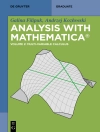Imagine mathematics, imagine with the help of mathematics, imagine new worlds, new geometries, new forms. This book is intended to contribute to grasping how much that is interesting and new is happening in the relationships between mathematics, imagination and culture. With a look at the past, at figures and events, that help to understand the phenomena of today.
It is no coincidence that this volume contains an homage to the great Italian artist of the 1700s, Andrea Pozzo, and his perspective views. Theatre, art and architecture are the topics of choice, along with music, literature and cinema. No less important are applications of mathematics to medicine and economics.
The treatment is rigorous but captivating, detailed but full of evocations, an all-embracing look at the world of mathematics and culture
Spis treści
The Many Faces of Lorenz Knots by M. Abate.- Lost in a Good Book: Jorge Borges’ Inescapable Labyrinth by W.G. Bloch.- The Mobius Strip by E. Blondeau.- The Unreasonable Effectiveness of Mathematics in Human Sciences: The Attribution of Texts to Antonio Gramsci by D. Benedetto, E. Caglioti, M. Degli Esposti.- Exactitude and Extravagance: Andrea Pozzo’s “Viewpoint” by F. Camerota.- Numeracy, Metrology and Mathematics in Mesopotamia: Social and Cultural Practices by G. Chambon.- The Fantastic World of Tor’ Bled-Nam by M. Emmer.- From Brigitte Bardot to Angelina Jolie by M. Emmer.- Visual Harmonies: an Exhibition on Art and Math by M. Emmer.- The Reconstruction of the Teatro La Fenice: “splendidezze” and “dorature” (Gleam and Gilding) by E. Fabbri.- Hypatia’s Dream by M. Vincenzi.- E Pluribus Unum by M. Li Calzi.- Origami and Partial Differential Equations by P. Marcellini, E. Paolini.- Modern geometry versus modern architecture by I. Birindelli, R. Cedrone.- The Apse Scenes in the Prospective Inventions of Andrea Pozzo by S. Carandini.- Emilio Prini, Alison Knowles, and Art’s Logic by C. Lauf.- Connecting Ventricular Assist Devices to the Aorta: a Numerical Model by J. Bonnemain, S. Deparis, A. Quarteroni.- Aperiodic Tiling by G.M. Todesco.- Andrea Pozzo: Art, Culture and Mathematics by M. Costamagna.- Women’s Contributions to the Progress of Mathematics: Lights and Shadows by E. Strickland.- The Mathematical Ideas of Luca Pacioli Depicted by Iacopo de’ Barbari in the Doppio ritratto by E. Gamba.- All the numbers end in numbers. On a work by Alighiero Boetti by A. Valle.- De divina proportione: From a Renaissance Treatise to a Multimedia Work for Theatre by S. Sorini.- Waiting for ABRACADABRA. Occurrences of words and leading numbers by E. De Santis, F. Spizzichino.-
O autorze
Michele Emmer is professor of mathematics at La Sapienza University in Rome. He has made eighteen films in the series “Arte e matematica”, including a film on Escher. He is the editor of the book series “Mathematics and Culture” (Springer) and “The Visual Mind” (MIT Press). His latest books are: Bolle di sapone tra arte e matematica (Bollati Boringhieri, 2009), winner of the 2010 Viareggio Prize; Flatlandia by E. Abbott, accompanied a film on DVD by the same name with music by Ennio Morricone (Bollati Boringhieri, 2008); Visibili armonie. Arte cinema teatro e matematica (Bollati Boringhieri, 2007); The Visual Mind 2 (MIT Press, 2006); M. C. Escher’s Legacy (Springer, 2003), Mathematics and Culture VI (Springer, 2009); Numeri immaginari. Cinema e matematica (Bollati Boringhieri, 2011); Matematica e cultura 2011 (Springer, 2011).












